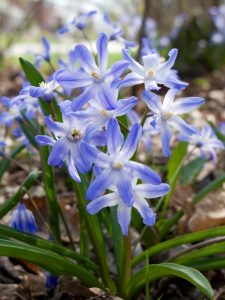Staying at home gives time to plan gardens, think spring
By Cathy Janek For Chronicle Media — April 2, 2020
Glory-of-the-Snow (Chionodoxa luciliae) are some of the earliest spring blooms that will appear in April. Now is the time to watch for bulbs to sprout, but be careful not to clear debris just yet. (Photo courtesy of University of Illinois Extension)
“Regardless of what is happening to us, spring is still happening,” said Richard Hentschel, horticulture educator with the University of Illinois Extension for DuPage, Kane and Kendall counties.
“We will have to deal with our yard, and I don’t mean that in a bad way. We may have to modify how we do it,” he said. “You can be out there without being shoulder to shoulder with anyone — so with regard to social distancing it is still something you can do.”
Plus, he added that landscape services were deemed an essential service by Gov. J.B. Pritzker during the statewide shutdown due to the COVID-19 pandemic.
For those that don’t own a lawn mower, he added, soon “the lawns will have to be mowed.”
For right now, Hentschel says from taking a walk around your yard, to assessing any damage or picking up debris, to organizing your gardening equipment including the lawn mower, there is much that can be done in these very early days of spring gardening.
Through the University of Illinois Master Gardener program, each year, hundreds of volunteers field questions about landscaping and gardening practices — in person, over the phone, and via email.
However, due to the obvious concerns related to the coronavirus (COVID-19) outbreak, all questions are being handled via email.
Hentschel who writes a blog for the University of Illinois Extension called “Over the Garden Fence” said, “The lawn probably has grown back into the beds—making edging a project for later in the season.”
But not just yet.
“The ground is really muddy. It would make edging very difficult, and you won’t like the results,” Hentschel added.
The same goes for raking lawns. The freezing and thawing of winter pushes tufts of grass and that is why it is so bumpy looking right now.
“If you took a hard rake to it, the clumps would literally come out of the ground—a leaf rake is preferred right now,” he said.
Gardeners can get to work indoors by beginning to start seeds that can be transplanted later into the garden.
“Sowing seeds can be a fun family adventure,” Hentschel said.
He does recommend not starting all the seeds at once.
“Sow some seeds this week. Wait a week to 10 days to create a window to plant at an appropriate time based on the weather,” Hentschel explained.
With tulip bulbs sprouting up and buds beginning to appear on trees, Julie Janoski, plant clinic manager at the Morton Arboretum “encourages gardeners to wait until the weather looks consistently warmer” to get into the flower beds.
Janoski said even she was tempted to rake the leaves away from her budding tulips, but then thought the better of it.
If the weather turns cold again “pulling old leaves and cutting everything down could expose your plants to a hard freeze which could really knock them back,” Janoski said.
“Walking on wet, soggy soil or pushing your wheelbarrow through it can compact the soil, which in Illinois tends to be clay, that breaks down the structure,” she added.
Janoski recommends things homeowners can do in these early days of spring and confined to our

Families can make the most of the Stay at Home directive due to the coronavirus outbreak by getting a start on spring planting indoors. “Sow some seeds this week,” said Richard Hentschel, horticulture educator with the University of Illinois Extension
homes:
- Pick up sticks and debris
- Cut back ornamental grasses
- Assess trees, shrubs, and bushes that were damaged last year
- Prune summer flower and shrubs (not spring flowers and shrubs)
“Now is the time to spray Magnolia trees that suffered from Magnolia scale with dormant oil before the leaves come out,” she added.
A bit contradictory to most plants, Janoski explained it is OK to prune the arrowwood viburnum.
Viburnum leaf beetles have been increasingly found in the Chicagoland area and if left on plants could eventually kill it, she said.
“Over winter egg sacs can form underneath the stems of the viburnum,” Janoski added.
As the weather warms up and the soil dries up a bit, Janoski said, “it is a great time to move trees and shrubs, transplant perennials, divide perennials, mulch, and edge.”
Be aware, the average last frost date in Northern Illinois is May 15. “Lately, we have experienced big swings in weather. It will be nice and warm and then get cold and then warm again,” she added.
Starting in April, Janoski recommended to stop pruning Oak and Elm trees because they are susceptible to disease during the growing period.
Now is not the time to prune trees that bleed, Janoski said. “The sap will run on maples and birches.”
Toward the end of April is a great time to plant trees and shrubs,” she added.
Although temporarily closed due to precautions related to the coronavirus, questions can be submitted via email to the University of Illinois Extension at uiemg-kane@illinois.edu or to the Morton Arboretum at plantclinic@mortonarb.org.
ADVICE FROM THE EXPERTS
Garden Question Resources
Morton Arboretum Plant Clinic
Due to the coronavirus (COVID-19), the Plant Clinic offices are closed until further notice, but questions can be answered via email at plantclinic@mortonarb.org.
The Plant Clinic can be found across the courtyard from the Visitor Center in Lisle. During normal operating times, April through October, it is open from 10 a.m. to 4 p.m. Monday through Saturday. November through March, it is open from 11 a.m. to 3 p.m. Monday through Friday, call 630-719-2424, or email plantclinic@mortonarb.org.
University of Illinois Extension
Master Gardeners
Closed until at least May 31. Email questions may be sent to uiemg-kane@illinois.edu
During normal operating times, gardeners may phone (630) 584-6166 from April to September, Monday to Friday, 10 a.m.to 2 p.m. and from March and October, Monday, Wednesday, Friday from 10 a.m. to 2 p.m.









